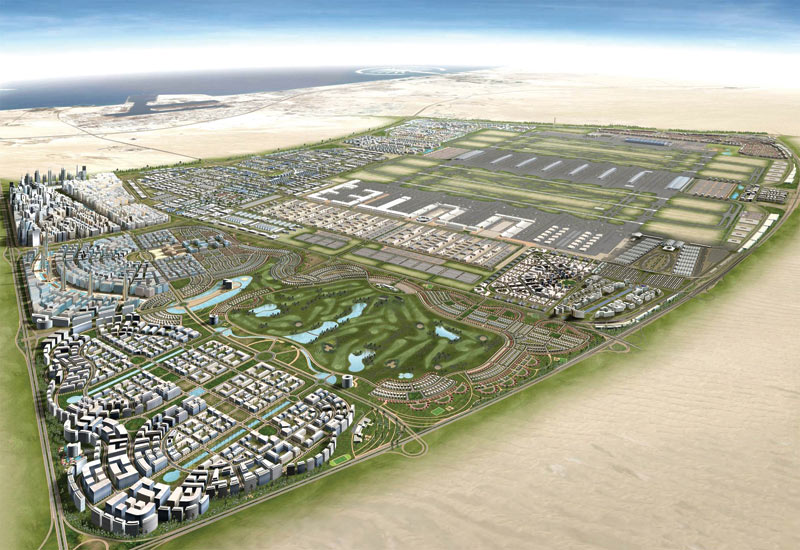2 Dubai World Central
Dubai World Central, located in the vicinity of the Jebel Ali Port and Free Zone in ‘New Dubai’ is a multi-phase development of six clustered zones: Dubai Logistics City (DLC), Commercial City, Residential City, Aviation City and Golf City, with the world’s largest airport — Dubai World Central-Al Maktoum International (DWC-AMI) at its heart.
The 140km² development will also be home to the region’s first integrated, multi-modal transportation platform connecting air, sea and land.
The costs for the entire DWC development (including all clusters) has been estimated in excess of US $32 billion and work is in progress on the $820 million phase one of DWC-AMI.

Advertisement
Here ATN speaks to DWC-AMI vice president Andrew Walsh about the opening of phase one — which will take place in June 2010 — and the plan for years ahead.
ATN: Which airlines are likely to move into DWC-AMI when phase one is open?
We are still talking to a range of carriers — commercial, cargo, government aviation, low-cost, freighters etc — but the level of attractiveness is going to be down to each airline’s own personal product. We are talking to a combination of existing airlines and new entrants, but nothing is confirmed yet.
ATN: What are the benefits of airlines moving to Al Maktoum Inernational?
The real benefit is that we will be a multi-modal hub in that we can take advantage of the nearby seaport (at Jebel Ali) plus we have the road network into Dubai, Al Ain, Abu Dhabi and into Saudi Arabia. This is very attractive for the cargo industry.
The benefits for the passenger airlines is certainly a less-congested airport [than Dubai International], plus the close proximity to new Dubai.
We do recognise the current difficulties for Dubai International and the concentrated land mass around it, whereas AMI will be far less congested. There is better access to Abu Dhabi and Al Ain and the by-pass road [that is being extended to the airport] will make it much easier to travel to Sharjah and the Northern Emirates.
ATN: What will be the total capacity of the two airports when phase one is opened?
We reached 40.5 million passengers at Dubai International in 2009 and will have 46 million by the end of 2010. At DWC-AMI we will have one million passengers by the end of 2010 so that’s 47 million across the two airports in total by the end of the year.
What’s actually available is five million at DWC-AMI [for phase one] and 65 million at Dubai International. With expansion [at the latter], that will increase to 75 million by the end of 2012 with the opening of concourse three. Of course, when it’s completed, DWC-AMI will have the capacity for 160 million.
ATN: When will phase two open?
We are not sure but there will be a series of developments opening in between phases one and two, but it could be another 10 years before the passenger terminals are open.
ATN: Will the two airports both be operational when DWC-AMI is completed?
DWC-AMI is always the long-term solution for Dubai because capacity constraints at Dubai International are recognised.
The absolute capacity at Dubai International is 90 million, but in order for the UAE and Emirates Airline to expand, we need more capacity than that. The decision about how they might work together is still underway.
ATN: From what sources will demand for DWC-AMI be generated?
It’s important that we look at the passenger side. We have said for some time that we would exceed 40 million passengers at Dubai International in 2009 and we had already done that before the end of the year.
Unlike many airports globally, we continue to report growth. Over the last few months we have seen double-digit growth (year on year in terms of passenger numbers). Of course, the growth is not as strong as we witnessed from 2007 to 2008, but never-the-less, it is positive.
It’s the same on the cargo side where we have seen marginal growth this year. In the list of top 10 airports in the world (where we are number five) the other nine airports have lost volume, but we are growing.
DWC-AMI is located in a place that brings the airport and seaport together, plus we are a global hub that brings three continents — Europe, Africa and Asia — together. We are a multi-modal hub and it’s important to have an airport that can grow and expand.
Al MAKTOUM INTERNATIONAL
PHASE ONE (JUNE 2010):
- A single A380 compatible runway
- Passenger terminal with capacity of five million passengers per annum (expandable to seven million) at a cost of $275 million
- A cargo terminal building with a capacity of 250,000 tonnes per annum (expandable to 600,000 tonnes) at a cost of $76 million
- A 92-metre air traffic control tower
WHEN COMPLETED:
- Up to four passenger terminals
- 160 million passengers per annum (compared to 90 million at Atlanta)
- A final cargo capacity of 12 million tonnes per annum
- Five parallel runways, 4.5km long, each separated by a minimum of 800-metres









 Search our database of more than 2,700 industry companies
Search our database of more than 2,700 industry companies









